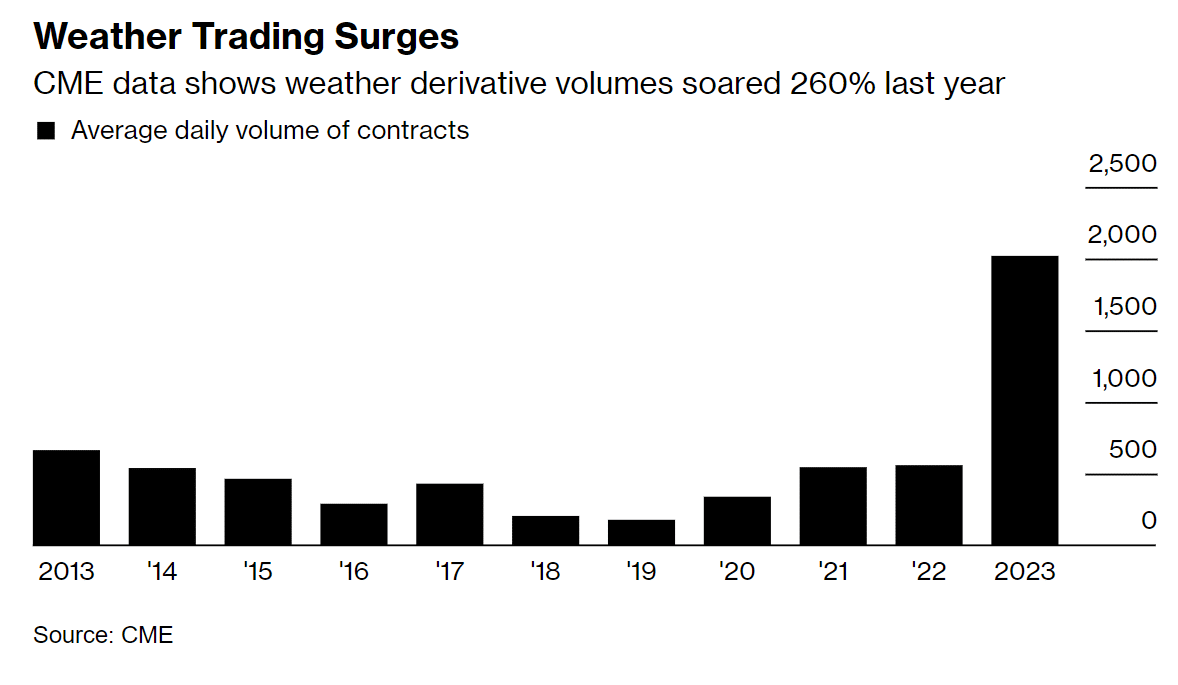As companies and investors grapple with climate risks, a niche segment of Wall Street is gaining attention for offering protection against weather-related disruptions.
The surge in demand for weather derivatives is driven by rising climate volatility and regulatory pressures, with average trading volumes soaring more than 260% in 2023, according to the CME Group. This reflects a growing awareness of the potential impact of weather events on businesses’ bottom lines.
The Meteoric Surge in Weather Derivatives
Weather derivatives, which provide a hedge against less severe but more common meteorological threats, are experiencing significant growth compared to better-known weather bets like catastrophe bonds.
Unlike catastrophe bonds, which typically cover extreme events like 100-year storms, weather derivatives offer protection against a range of weather conditions such as excessive rainfall or high temperatures, which can impact industries like tourism, agriculture, and energy.
With weather derivatives, the seller assumes the risk associated with adverse weather conditions in exchange for a premium. Should no adverse weather events occur before the contract’s expiration, the seller stands to make a profit. Conversely, if unexpected or unfavorable weather conditions arise, the buyer of the derivative can claim the agreed-upon amount.
The expansion of weather derivative offerings by exchanges like the CME Group underscores the increasing demand for these products. Traders and companies now have access to options covering a variety of locations, reflecting the global reach of weather-related risks.
In 2023, the average trading volumes for listed products experienced a remarkable surge of over 260%, as reported by the CME Group. Additionally, the number of outstanding contracts is currently 48% higher compared to the previous year.
Despite this significant increase in publicly traded activity, industry estimates suggest that this segment represents only a fraction of the overall market, potentially accounting for as little as 10% of all activity. The outstanding derivatives in this sector may hold a notional value of up to $25 billion.
This growth trajectory is fueled by corporations’ growing recognition of their exposure to weather-related risks, driven by operational impacts, regulatory requirements, and investor pressures.
Forecasting Financial Climate Change
Regulators in jurisdictions like Europe and the US are increasingly requiring companies to disclose climate-related risks and mitigation strategies. This regulatory push, coupled with investor expectations, is compelling businesses to assess and address their exposure to weather-related risks.
As a result, industries ranging from energy to agriculture are turning to weather derivatives to manage their risk exposure.
The energy sector, in particular, is embracing weather derivatives to mitigate the impact of weather fluctuations on demand and supply. Companies use weather hedges to offset the effects of warm weather on heating oil sales, while renewable energy producers seek to manage the intermittency of solar and wind power generation through weather derivatives.
In particular, Star Group LP, a US-based provider of home heating and air conditioning products and a distributor of heating oil, employs hedging strategies to minimize the impact of warm weather on its cash flows.
As per its financial statements, the company has entered into contracts that allow it to potentially receive up to $12.5 million if temperatures recorded during the coverage period from November through March surpass specific thresholds.
Following payouts received in recent financial years, including the full benefit in 2023, the maximum payment under these contracts has increased to $15 million for those payable in 2025.
-
Advancements in meteorological science and technology are driving the development of more sophisticated weather derivative products.
Companies like Syngenta are leveraging derivatives to offer innovative solutions to farmers, such as cash refunds for crop failures due to adverse weather conditions. These programs, underpinned by derivatives, demonstrate the potential for weather derivatives to protect individual end-users from climate-related risks.
For example, Syngenta’s AgriClime program offers a unique proposition to farmers, pledging a cash refund for up to 30% of their purchase of specific crops if nature fails to provide suitable growing conditions. This initiative aims to provide a safety net for farmers in the event of adverse weather conditions, ensuring that their livelihoods are not jeopardized.
During the UK’s last planting season, such payouts were made to 99% of Syngenta’s hybrid barley customers, underscoring the program’s effectiveness in supporting farmers during challenging times. Syngenta said that its AgriClime program extends to cover a variety of crops across over 50,000 farms spanning 17 countries.
Navigating the Climate Economy: Challenges and Opportunities in Weather Derivatives
However, the growth of the weather derivatives market raises questions about moral hazard and the effectiveness of financial solutions in addressing climate change.
Critics argue that mitigating the financial impact of weather events may reduce incentives for corporations to address their contributions to climate change. Despite these concerns, industry practitioners emphasize the positive role of weather derivatives in funding renewable energy projects and protecting communities from climate challenges.
Challenges such as basis risk and lack of secondary trading liquidity have historically hindered the growth of the weather derivatives market. Basis risk, in particular, poses challenges in effectively hedging against localized weather risks.
However, market players remain optimistic about the future of weather derivatives, citing their growing relevance in addressing climate-related risks and their increasing integration into mainstream financial markets.
In conclusion, the weather derivatives market is experiencing rapid growth as businesses seek to mitigate the financial impact of climate-related risks. While challenges remain, the increasing demand for weather derivatives underscores their importance in managing weather-related uncertainties in an era of climate change.



